Earlier this week, the Water for Colorado Coalition convened a group of state legislators for a discussion on drought in the Colorado River Basin and why it matters to our state. The conversation ranged from developing a deeper understanding of the river’s management, history, and hydrology to examining meaningful solutions and contemplating the economic and interpersonal benefits that rivers provide to Coloradans.
The State of the Colorado River
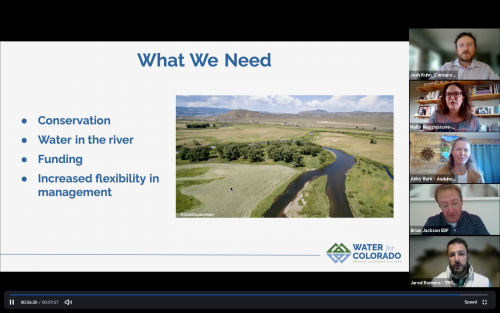 Josh Kuhn, water advocate for Conservation Colorado, moderated a panel of four coalition partners. The virtual event drew a large group of bipartisan legislators, aides, and policy advisors from across Colorado. We began with a presentation from Theodore Roosevelt Conservation’s Director of Strategic Partnerships, Jared Romero who provided an overview of current Basin-wide hydrology, the population growth and framed the challenges facing our precious water resources in the face of climate change.
Josh Kuhn, water advocate for Conservation Colorado, moderated a panel of four coalition partners. The virtual event drew a large group of bipartisan legislators, aides, and policy advisors from across Colorado. We began with a presentation from Theodore Roosevelt Conservation’s Director of Strategic Partnerships, Jared Romero who provided an overview of current Basin-wide hydrology, the population growth and framed the challenges facing our precious water resources in the face of climate change.
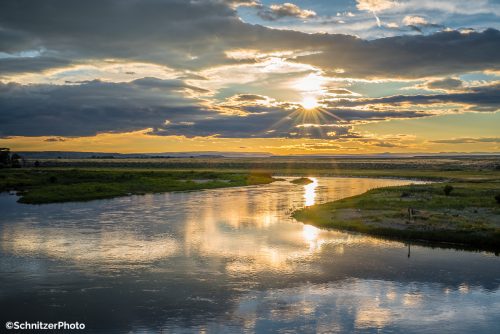
Upper Colorado River photo by Russ Schnitzer (@SchnitzerPhoto)
Particularly salient were the sobering statistics around changes in Colorado River health and flows over the last few decades, including a 20% overall decline in flows since 2000, with another 20-30% decline projected in the coming decades. Parched soil, due to extreme heat and catastrophic wildfires have prevented snowpack from reaching the river. In 2021, snowfall in the Basin was at 90% of average, but only 30% of snowmelt actually reached the river — resulting in 60% of the snowpack’s moisture being absorbed by abnormally dry soils rather than entering the river system. This is a direct result of increased temperatures and years of below average precipitation in the area driven by climate change. Colorado has warmed an average of 2.7°F in the last 30 years, and for every 1.8°F of temperature increase now and in the future, scientists predict the river will lose another 10% of its flows.
Understanding the Colorado’s River’s Role in Our State
Understanding the dire circumstances facing Colorado’s rivers and water is critical to inspiring action, and so is understanding the history of water management in the region. Abby Burk, western rivers program director for Audubon Rockies, gave the audience a crash course on the history of the Colorado River, including how water is apportioned between the seven states and Mexico, why there is an Upper Basin and a Lower Basin, and other key moments in the history of the “Law of the River” – a group of several decrees, agreements, and legal contracts that guides how the Colorado River is managed.
Of critical importance in both Abby and Jared’s presentations was the understanding that the Colorado River touches all people and communities within our state – and beyond. Not only is it important for farming, ranching, and recreation, but provides drinking water to 40 million people and 30 tribal nations, many of which are still severely disadvantaged by historical inequities in river apportionment. As Abby said, “It is unacceptable that in the 21st century, some must travel for miles to collect water that is safe for drinking and everyday use.” COVID-19 highlighted those long standing inequities, which are only being exacerbated by continued drought and dire hydrology.
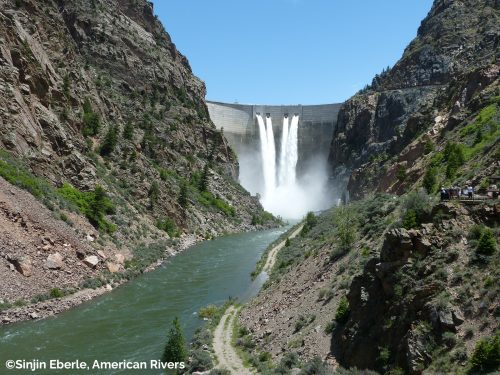
A reservoir spill at Blue Mesa Reservoir
Before transitioning into conversations about solutions, Business for Water Stewardship’s (BWS) Colorado River Basin Director, Molly Mugglestone, spoke to the critical importance of rivers as an economic driver and communal gathering places. Citing numbers from an economic study conducted by BWS — she noted water-related recreation drives $18.8 billion annually in economic output for Colorado — and illustrated the extent to which declining flows and extreme drought hurt not only our industries, but the very way of life that Coloradans value. “We all gather and enjoy our rivers and did so even more during COVID. Families picnic, friends float and fish, we hike along the river banks- everyone regardless of socioeconomic status can access waterways in our state which makes them a critical resource we need to protect.” She highlighted research from Wallace J, Nichols in his book Blue Mind that shows “how being near, in, on or under water can make you happier, healthier, more connected and better at what you do.”
Working Toward Solutions
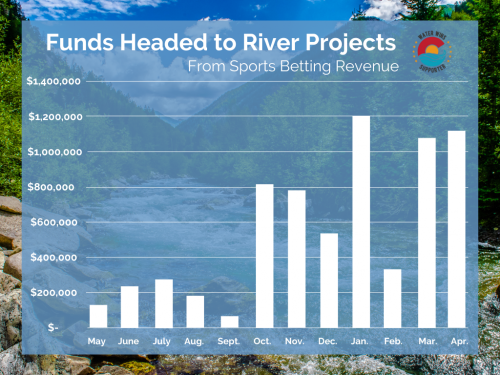 To conclude the discussion, Brian Jackon, western water senior manager at the Environmental Defense Fund, pivoted toward urgently needed actions and solutions identified by the coalition. Water, he said, is far too important to be left just to the experts — it demands collaboration across sectors and continued prioritization from both a policy and funding perspective.
To conclude the discussion, Brian Jackon, western water senior manager at the Environmental Defense Fund, pivoted toward urgently needed actions and solutions identified by the coalition. Water, he said, is far too important to be left just to the experts — it demands collaboration across sectors and continued prioritization from both a policy and funding perspective.
He illustrated that “water wins” by citing successful initiatives such as the passage of Proposition DD, which legalized sports betting in 2019, allocating funds to the implementation of the state’s Water Plan, and the 2020 7A initiatives in the Left Hand St. Vrain Water Conservancy District and Colorado River Water and Conservancy District, increasing property taxes to fund regional water projects. These initiatives prove that Coloradans, when given the option, understand the importance of water conservation.
A More Resilient Future for Colorado
Josh from Conservation Colorado concluded that while myriad specific policy recommendations can be made — and will be collaborated upon in the future — the core of what our state needs can be boiled down into four key categories: conservation, funding, keeping water in rivers, and increased flexibility in management approaches. The coalition reminded legislators that climate leadership is water leadership and called on legislators to prioritize capturing once in a generation federal funding to help conserve more water and restore or maintain healthy flowing rivers. These federal dollars can, and should be spent toward implementation of an updated state Water Plan (due at the end of 2022), that meets the moment and is inclusive of all Coloradans. If we can take these steps, we’ll be putting Colorado on a path that supports rivers and increases our state’s resilience to climate change and drought.
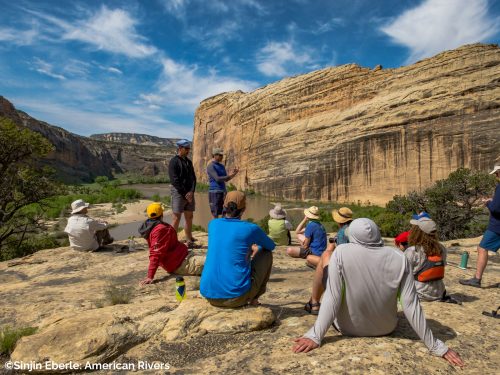
Photo Credit: Sinjin Eberle
Water connects all of us. This gathering was one of many conversations Water for Colorado plans to have with state decision-makers around water and rivers and their critical importance to our state’s way of life and economic security. We hope that our coalition remains a resource for anyone interested in understanding more about the way Western water is managed, and how we can increase resilience and flexibility through projects, funding, and policy. You can always reach out, we want to work together — progress will only be made through mutual understanding and commitment to collaborative action.